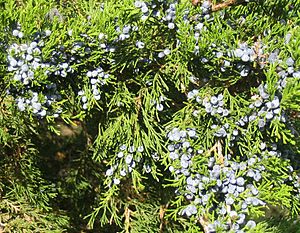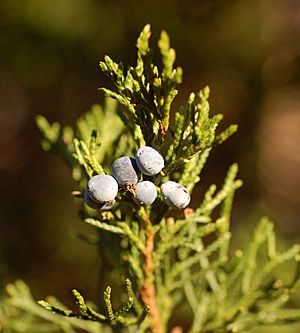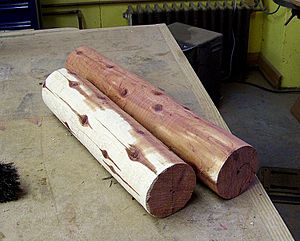Eastern redcedar facts for kids
Quick facts for kids Eastern redcedar |
|
|---|---|
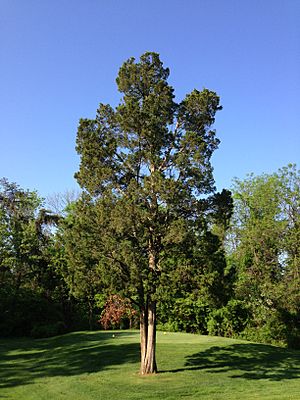 |
|
| Juniperus virginiana incorporated into a golf course in northern Virginia | |
| Conservation status | |
| Scientific classification | |
| Genus: |
Juniperus
|
| Species: |
virginiana
|
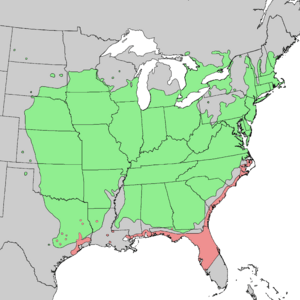 |
|
| Natural distribution of varieties: J. virginiana var. virginiana (green) and J. virginiana var. silicicola (red) |
|
The Eastern Redcedar (scientific name: Juniperus virginiana) is a type of juniper tree. It's also known by other names like red cedar or aromatic cedar. This tree grows naturally across eastern North America. You can find it from southeastern Canada all the way down to the Gulf of Mexico. It grows east of the Great Plains.
In areas further west, you'll find similar trees. These include the Rocky Mountain juniper and the Ashe juniper.
Contents
What Does the Eastern Redcedar Look Like?
The Eastern Redcedar is an evergreen tree. This means it keeps its leaves all year round. It grows slowly but can become quite dense. On poor soil, it might stay a bush. But usually, it grows into a tree about 5 to 20 meters (16 to 66 feet) tall. Its trunk can be 30 to 100 centimeters (12 to 39 inches) wide. Some rare trees have been found to be much taller. The oldest known Eastern Redcedar was 940 years old!
The tree's bark is reddish-brown. It's fibrous and peels off in thin strips. The leaves come in two main types:
- Young leaves: These are sharp and needle-like. They are about 5 to 10 millimeters (0.2 to 0.4 inches) long. You see them on young plants (up to 3 years old). They can also appear on older trees, especially in shady spots.
- Adult leaves: These are scale-like and lie flat against the branch. They are shorter, about 2 to 4 millimeters (0.08 to 0.16 inches) long. They are arranged in pairs or sometimes in groups of three.
The tree produces small, round seed cones. People often call these "juniper berries." They are 3 to 7 millimeters (0.12 to 0.28 inches) long. They start dark purple-blue and have a white, waxy coating. This makes them look sky-blue. Each "berry" holds one to three seeds. They ripen about 6 to 8 months after the tree is pollinated. These "berries" are a key winter food for many birds. Birds help spread the seeds around.
The pollen cones are smaller, about 2 to 3 millimeters (0.08 to 0.12 inches) long. They release pollen in late winter or early spring. Most Eastern Redcedar trees are dioecious. This means a tree has either pollen cones or seed cones, but not both. However, some trees can have both types of cones.
What Are the Different Types of Eastern Redcedar?
There are two main types, or varieties, of Eastern Redcedar:
- Eastern Juniper / Redcedar (Juniperus virginiana var. virginiana): This type is found in eastern North America. Its range goes from Maine to South Dakota and down to Florida and Texas. Its cones are a bit larger (4–7 mm). The scale leaves have pointed tips, and the bark is reddish-brown.
- Southern or Sand Juniper / Redcedar (Juniperus virginiana var. silicicola): This type grows along the Atlantic and Gulf coasts. You can find it from southeastern Virginia down to central Florida and west to Texas. Its cones are smaller (3–4 mm). The scale leaves have blunt tips, and the bark is orange-brown.
Where Does the Eastern Redcedar Grow?
The Eastern Redcedar is a pioneer species. This means it's one of the first trees to grow in areas that have been cleared or damaged. It can live for over 900 years, which is very long for a pioneer species. You often see it in old fields, grasslands, or on limestone hills. It also grows along highways and near new construction sites.
This tree can host a fungus called cedar–apple rust. This disease affects apple trees. Because of this, some farmers remove Eastern Redcedars near apple orchards.
Why Is Eastern Redcedar Sometimes a Problem?
In many places, the Eastern Redcedar is considered an invasive species, even though it's native. It doesn't handle fire well. Historically, natural wildfires kept these trees from spreading too much. Low branches would catch fire, and the flames would climb the tree, burning it completely. Grasses, however, recover quickly from these fires.
But with more towns and farms, fires are often stopped by roads or plowed fields. This allows the Eastern Redcedar to spread into grasslands. If left unchecked, these trees can harm grasslands. People often remove them by cutting or using controlled fires. Dense groups of these trees can also make wildfires spread faster, especially during droughts.
Eastern Redcedar trees also benefit from higher levels of CO2 in the air. Many grasses, which compete with the juniper, don't benefit as much.
How Does Eastern Redcedar Affect the Environment?
When Eastern Redcedar takes over grasslands, it can reduce the amount of food available for grazing animals. Its low branches and wide base take up a lot of space. The thick leaves block sunlight, so few other plants can grow underneath. The needles that fall can also make the soil more alkaline. This makes it harder for other plants to get nutrients like phosphorus.
However, studies have shown that areas where Eastern Redcedar forests replace grasslands can have similar or even higher levels of soil nitrogen. These forests also store much more carbon, especially above ground in the trees themselves.
Cedar waxwing birds love to eat the "berries" of these junipers. The seeds pass through the birds quickly. Seeds that have been eaten by these birds are about three times more likely to sprout than those that haven't. Many other birds and mammals also eat the "berries."
How Do People Use Eastern Redcedar?
The wood of the Eastern Redcedar is very useful. It's fragrant, fine-grained, soft, and light. The reddish heartwood is very strong and lasts a long time, even when it's in contact with soil. Because it resists decay, it's often used for fence posts.
Moths don't like the smell of the wood. This makes it popular for lining clothes chests and closets. These are often called "cedar chests" or "cedar closets." The wood can also be used to make excellent English longbows. The best parts of the heartwood were once used to make pencils. However, by the 1940s, there wasn't enough of it, so Incense cedar wood largely replaced it.
Some cedar oil is made by steaming wood shavings. This oil contains many different natural chemicals called terpenes. The main parts of this essential oil are alpha-cedrene, thujopsene, and cedrol. The "berries" also produce an essential oil, which mostly contains D-Limonene.
Historically, Native American tribes used juniper poles to mark their hunting territories. The city of Baton Rouge, Louisiana, got its name from these reddish poles. Some tribes still use the wood in special ceremonies.
The ancient Mississippian culture built large timber circles called the Cahokia Woodhenge in Illinois. They used huge Eastern Redcedar logs for these structures. One circle, built around 1000 BC, had 48 posts in a 410-foot-wide circle, with a 49th pole in the center.
Many Native American cultures believe that the smoke from burning Eastern Redcedar can help remove bad spirits before a ceremony, like a healing ceremony.
During the Dust Bowl in the 1930s, farmers were encouraged to plant rows of Eastern Redcedar. These rows acted as windbreaks, called shelterbelts, across the Great Plains. The trees grow well even in tough conditions. They can handle both drought and cold. They also thrive in rocky, sandy, and clay soils. They can be planted close together and still grow tall, forming a strong windbreak quickly.
Some special types of Eastern Redcedar, called cultivars, have been grown for gardens. Examples include 'Canaertii' (a narrow, cone-shaped female tree) and 'Goldspire' (a narrow, cone-shaped tree with yellow leaves).
In the Ozarks region, Eastern Redcedar is often used as a Christmas tree.
Can Eastern Redcedar Cause Allergies?
The pollen from Eastern Redcedar is known to cause allergies. It's not as strong as the pollen from the related Ashe juniper, which releases its pollen about a month earlier. However, if you're allergic to one, you're often allergic to both. Eastern Redcedar releases pollen from late winter through early spring. So, an allergy that starts with Ashe juniper in winter might continue into spring with Eastern Redcedar.
Touching the leaves or wood can also cause a mild skin rash in some people.
See also
 In Spanish: Sabina colorada de Virginia para niños
In Spanish: Sabina colorada de Virginia para niños



